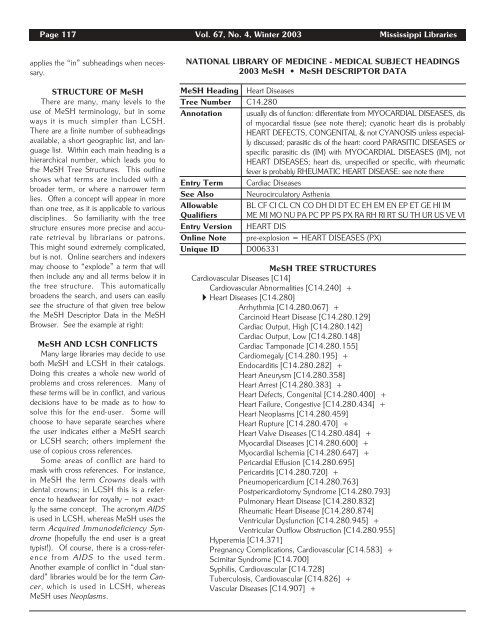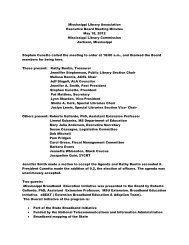Full Text (PDF) - Mississippi Library Association
Full Text (PDF) - Mississippi Library Association
Full Text (PDF) - Mississippi Library Association
You also want an ePaper? Increase the reach of your titles
YUMPU automatically turns print PDFs into web optimized ePapers that Google loves.
Page 117 Vol. 67, No. 4, Winter 2003 <strong>Mississippi</strong> Libraries<br />
applies the “in” subheadings when necessary.<br />
STRUCTURE OF MeSH<br />
There are many, many levels to the<br />
use of MeSH terminology, but in some<br />
ways it is much simpler than LCSH.<br />
There are a finite number of subheadings<br />
available, a short geographic list, and language<br />
list. Within each main heading is a<br />
hierarchical number, which leads you to<br />
the MeSH Tree Structures. This outline<br />
shows what terms are included with a<br />
broader term, or where a narrower term<br />
lies. Often a concept will appear in more<br />
than one tree, as it is applicable to various<br />
disciplines. So familiarity with the tree<br />
structure ensures more precise and accurate<br />
retrieval by librarians or patrons.<br />
This might sound extremely complicated,<br />
but is not. Online searchers and indexers<br />
may choose to “explode” a term that will<br />
then include any and all terms below it in<br />
the tree structure. This automatically<br />
broadens the search, and users can easily<br />
see the structure of that given tree below<br />
the MeSH Descriptor Data in the MeSH<br />
Browser. See the example at right:<br />
MeSH AND LCSH CONFLICTS<br />
Many large libraries may decide to use<br />
both MeSH and LCSH in their catalogs.<br />
Doing this creates a whole new world of<br />
problems and cross references. Many of<br />
these terms will be in conflict, and various<br />
decisions have to be made as to how to<br />
solve this for the end-user. Some will<br />
choose to have separate searches where<br />
the user indicates either a MeSH search<br />
or LCSH search; others implement the<br />
use of copious cross references.<br />
Some areas of conflict are hard to<br />
mask with cross references. For instance,<br />
in MeSH the term Crowns deals with<br />
dental crowns; in LCSH this is a reference<br />
to headwear for royalty – not exactly<br />
the same concept. The acronym AIDS<br />
is used in LCSH, whereas MeSH uses the<br />
term Acquired Immunodeficiency Syndrome<br />
(hopefully the end user is a great<br />
typist!). Of course, there is a cross-reference<br />
from AIDS to the used term.<br />
Another example of conflict in “dual standard”<br />
libraries would be for the term Cancer,<br />
which is used in LCSH, whereas<br />
MeSH uses Neoplasms.<br />
NATIONAL LIBRARY OF MEDICINE - MEDICAL SUBJECT HEADINGS<br />
2003 MeSH • MeSH DESCRIPTOR DATA<br />
MeSH Heading Heart Diseases<br />
Tree Number C14.280<br />
Annotation usually dis of function: differentiate from MYOCARDIAL DISEASES, dis<br />
of myocardial tissue (see note there); cyanotic heart dis is probably<br />
HEART DEFECTS, CONGENITAL & not CYANOSIS unless especially<br />
discussed; parasitic dis of the heart: coord PARASITIC DISEASES or<br />
specific parasitic dis (IM) with MYOCARDIAL DISEASES (IM), not<br />
HEART DISEASES; heart dis, unspecified or specific, with rheumatic<br />
fever is probably RHEUMATIC HEART DISEASE: see note there<br />
Entry Term Cardiac Diseases<br />
See Also Neurocirculatory Asthenia<br />
Allowable BL CF CI CL CN CO DH DI DT EC EH EM EN EP ET GE HI IM<br />
Qualifiers ME MI MO NU PA PC PP PS PX RA RH RI RT SU TH UR US VE VI<br />
Entry Version HEART DIS<br />
Online Note pre-explosion = HEART DISEASES (PX)<br />
Unique ID D006331<br />
MeSH TREE STRUCTURES<br />
Cardiovascular Diseases [C14]<br />
Cardiovascular Abnormalities [C14.240] +<br />
Heart Diseases [C14.280]<br />
Arrhythmia [C14.280.067] +<br />
Carcinoid Heart Disease [C14.280.129]<br />
Cardiac Output, High [C14.280.142]<br />
Cardiac Output, Low [C14.280.148]<br />
Cardiac Tamponade [C14.280.155]<br />
Cardiomegaly [C14.280.195] +<br />
Endocarditis [C14.280.282] +<br />
Heart Aneurysm [C14.280.358]<br />
Heart Arrest [C14.280.383] +<br />
Heart Defects, Congenital [C14.280.400] +<br />
Heart Failure, Congestive [C14.280.434] +<br />
Heart Neoplasms [C14.280.459]<br />
Heart Rupture [C14.280.470] +<br />
Heart Valve Diseases [C14.280.484] +<br />
Myocardial Diseases [C14.280.600] +<br />
Myocardial Ischemia [C14.280.647] +<br />
Pericardial Effusion [C14.280.695]<br />
Pericarditis [C14.280.720] +<br />
Pneumopericardium [C14.280.763]<br />
Postpericardiotomy Syndrome [C14.280.793]<br />
Pulmonary Heart Disease [C14.280.832]<br />
Rheumatic Heart Disease [C14.280.874]<br />
Ventricular Dysfunction [C14.280.945] +<br />
Ventricular Outflow Obstruction [C14.280.955]<br />
Hyperemia [C14.371]<br />
Pregnancy Complications, Cardiovascular [C14.583] +<br />
Scimitar Syndrome [C14.700]<br />
Syphilis, Cardiovascular [C14.728]<br />
Tuberculosis, Cardiovascular [C14.826] +<br />
Vascular Diseases [C14.907] +














